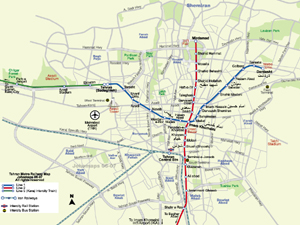|
|
伊朗 德黑蘭 |
|
德黑蘭地圖 |
|
|
德黑蘭地鐵圖 | |||
| 日期 | Aug, 2006年8月 | |||
| 格式 | jpeg | |||
| 尺寸 | 915 x 685 像素 (451 kb) | |||
| 版權擁有 | Johomaps! | |||
| 地圖使用之條件 |
版權持有人保留所有權利,有關本圖的使用權特許,請發電郵到 |
|||
| 更多資訊: | 使用 Adobe Illustrator 製作 | |||
|
即時德黑蘭出行資訊 |
||
|
資料 |
Adjective: Tehrani Tehran (From Wikipedia) Tehran (Persian: تهران, also transliterated as Teheran or Tehrān), population 7,160,094 (metropolitan: 14,000,000), and a land area of 658 square kilometers, is the capital city of Iran and the center of Tehran Province. Tehran is located at . More than half of the country's industry is based there. Industries include the manufacturing of cars, electronics and electrical equipment, military weaponry, textiles, sugar, cement, and chemical products. It is also a leading center for the sale of carpets and furniture. There is an oil refinery nearby. Tehran is a sprawling city at the foot of the Alborz mountain range with an immense network of highways unparalleled in western Asia. It is also the hub of the country's railway network. The city has numerous large museums, art centers, palace complexes and cultural centers. In addition to Persians, there is a population of Azeris in Tehran, as well as other ethnicities including Armenian, Assyrian, Kurdish and Jewish communities. 98.3% of Tehran's residents speak Persian. The city is dotted with mosques, and there are a number of churches and synagogues. History Excavations place the existence of settlements in Tehran as far back as 6000 BC. Tehran was well known as a village in the 9th century, but was less well-known than the city of Rhages which was flourishing nearby in the pre-Mongol era. In the 13th century, following the destruction of Ray by Mongols, many of its inhabitants fled to Tehran. In some sources of the Mongol era the city is mentioned as "Rhages's Tehran" (طهرانِ ری). The city is later mentioned in Hamdollah Mostowfi's Nuz'hat al-Qulub (written in 1340) as a famous village. Don Ruy Gonzáles de Clavijo, a Castilian ambassador, was probably the first European to visit Tehran, stopping in July 1404, while on a journey to Samarkand (now in Uzbekistan) and the Mongol capital at the time. At this time, the city of Tehran was unwalled. Tehran became a residence of the Safavid rulers in the 17th century. Tahmasp I built a bazaar and a wall around the city, but it somewhat fell out of favour after Abbas I turned sick when he was passing the city to go to a war with the Uzbeks. In the early 18th century, Karim Khan Zand ordered a palace, a harem, and a government office to be built in Tehran, possibly to declare the city his capital, but later moved his government to Shiraz. Tehran finally became the capital of Persia in 1795, when the Qajar king Agha Mohammad Khan was crowned in the city. It remains the capital to this day. During World War II, British and Soviet troops entered the city. Tehran was the site of the Teheran Conference in 1943, attended by US President Franklin D. Roosevelt, British Prime Minister Winston Churchill, and Soviet Premier Joseph Stalin. Following the war, the city's older landmarks suffered under the rule of Mohammad Reza Shah. The shah believed that ancient buildings such as large parts of the Golestan Palace, Takieh-ye Dowlat, The Toopkhooneh Square (pictured to the right), and others should not be part of a modern city. They were systematically destroyed and modern 1950s and 1960s buildings were built in their place. The decision to carry this out is presently largely seen as a foolish mistake that hurt the visual fabric of the city beyond repair. On September 8, 1978, demonstrations against the shah led to riots. The army reportedly opened fire on the demonstrating mob. Martial law was installed in the wake of the ensuing revolution, from 1978-80. During the 1980-88 Iran-Iraq War, Tehran was the scene of repeated Scud missile attacks and air strikes against random residential and industrial targets within the city, resulting in thousands of civilian casualties. Modern Tehran The Azadi Tower is the first landmark visitors come across when arriving from the Mehrabad International Airport. The tower has become an icon for Tehran and a national symbol of Iran. Tehran suffers from extremely serious traffic congestion and pollution problems. Respiratory ailments such as asthma are very common. Tehran has become so congested over the past decade that the government has considered moving the nation's capital to another city to alleviate these problems and help de-centralize the economy and population. But because Iran's economy and politics are so centralized, millions have little choice but to live and work in Tehran. The Peacock Throne of the Persian Shahs can be found in Tehran's Golestan Palace. Some of the important museums are National Museum of Iran, Sa'dabad Palaces Complex, Glassware and Ceramics Museum of Iran, The Carpet Museum of Iran, Tehran's Underglass painting Museum, and Niavaran Palace Complex. The Tehran Museum of Contemporary Art is also appealing to many because it features the works of great artists such as Van Gogh, Pablo Picasso and Andy Warhol. The huge Tehran International Fair organises many expositions. Its book expositions are especially popular. Tehran is also the seat of Iran's Parliament (the Majles). And Tehran is also home to the world's fourth tallest free standing structure, the Milad Tower. |

